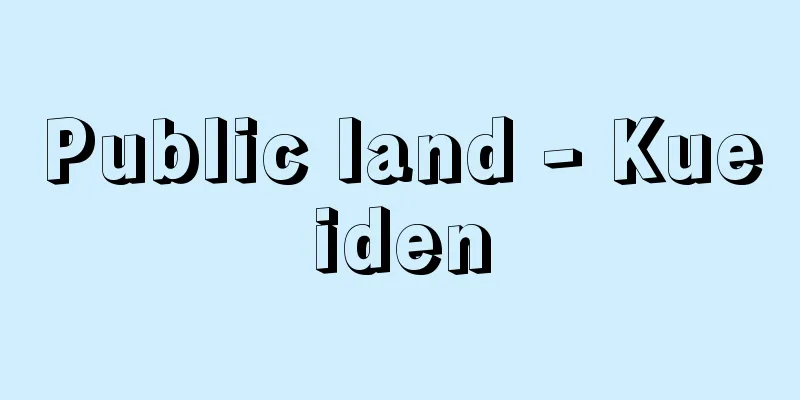Public land - Kueiden

|
It can also be read as "koueiden." (1) In the broad sense, it is used as a general term for government-run fields, various government-managed fields, imperially ordered fields, and publicly managed fields (in the narrow sense), as opposed to privately managed fields, but this is not a common usage. (2) In the narrow sense, it refers to publicly managed fields in Iwami Province in 813 (Kōnin 4), in the jurisdiction of Dazaifu (Kyushu) in 823 (Kōnin 14), and in Kazusa Province in 879 (Gangei 3), but generally it refers to the publicly managed fields in the jurisdiction of Dazaifu, the details of which are known in relatively detail. The Dazaifu Public Land Management System was put into place in the Dazaifu area in 823, as proposed by Dazaifu Daini Ono no Minemori. The plan was to allocate 12,095 cho of good quality land from the kubunden and joden fields of the nine provinces under its jurisdiction, to which 60,257 miners were sent, with five people cultivating one cho, and from among them, capable individuals were selected to oversee the cultivation of one cho or more, and to pay 1,080,421 bundles of rice harvested minus necessary expenses to the government, thereby increasing financial revenue. However, there were some differences between the original plan and the actual plan, such as the fact that the Dazaifu original plan called for this experiment to continue for 30 years, but the central government limited it to four years. The main purpose of this public land system was to stop collecting Choyo (handicraft products) from farmers, and instead obtain rice (land products) and trade (exchange) the rice for handicraft products, but there are differing opinions about its specific significance. Furthermore, the specific aspects of its implementation and its end are unclear. [Hideo Nakano] Hideo Nakano, "Research on the Disintegration Process of the Ritsuryo Society" (1979, Hanawa Shobo) Source: Shogakukan Encyclopedia Nipponica About Encyclopedia Nipponica Information | Legend |
|
「こうえいでん」とも読む。(1)広義には私営田に対するものとして、官田、諸司田(しょしでん)、勅旨田(ちょくしでん)、公営田(狭義)などの総称の意味で用いられるが、これは一般的用法ではない。(2)狭義には、813年(弘仁4)の石見(いわみ)国、823年(弘仁14)の大宰府(だざいふ)管内(九州)、879年(元慶3)の上総(かずさ)国などの公営田をいうが、一般的には、その内容が比較的詳細にわかる大宰府管内公営田制をいう。 大宰府管内公営田制は、823年、大宰大弐(だいに)小野岑守(みねもり)の建策によって大宰府管内において行われた。これは管内9か国の口分田(くぶんでん)および乗田(じょうでん)のなかから良田1万2095町を割き、それに徭丁(ようてい)6万0257人を投入して、5人で1町を耕作させ、そのなかから有能な者を選んで1町以上を監督させて耕営し、その収穫稲より必要経費を差し引いた108万0421束を納官し、財収増加を図る、というプランであった。ただし、大宰府の原案ではこの試みを30年間行うことになっていたのを、中央政府はそれを4年に限るなど、原案と実施案とでは若干の相違がある。この公営田制の主眼は、農民からの調庸(ちょうよう)(手工業生産物)の収取を停止し、そのかわりに稲(土地生産物)を手に入れ、その稲で手工業生産物を交易(交換)するというものであったが、その具体的意義づけに関しては異論がある。なお、その実施の具体的様相や終末などは不明である。 [中野栄夫] 『中野栄夫著『律令制社会解体過程の研究』(1979・塙書房)』 出典 小学館 日本大百科全書(ニッポニカ)日本大百科全書(ニッポニカ)について 情報 | 凡例 |
Recommend
Horizontal bulkhead - House bulkhead
… [Layout of watertight compartments] A watertigh...
Lady Amherst's pheasant (English spelling: Chrysolophus amherstiae)
Order Phasianidae, family Phasianidae. Males are 1...
Additional fee - additional fee
…This was linked to the incentive of granting tax...
Mountain climate - Sankakukiko
This refers to the climate that is unique to moun...
Garter knitting machine - Garter knitting machine
…The first treadle stocking knitting machine was ...
Mimurotoji Temple
This Shugen sect temple is located in Todo Shigad...
Yen Taxi - Entaku
Abbreviation for 1 Yen Taxi. It is a taxi fare sy...
Eisgruber, E.
...This was a time when cheap German lithographs ...
Augusta National Golf Club
In 1980, Isao Aoki competed with Jack Nicklaus fo...
Photographic emulsion - Shashin Nyuuzai
It is a dispersion of fine silver halide crystals...
Dzhugashvili,IV (English spelling)
…He was a leader of the Communist Party of the So...
Johor Bahru (English spelling)
Located at the southernmost tip of the Malay Penin...
Oniguchi (Oni-guchi) - Oni-guchi (English name) Strobilomyces floccopus
Basidiomycete fungi, order Acarinales, family Bole...
Chalukya Dynasty - Chalukyacho (English spelling)
A dynasty in South India. It is divided into thre...
Mitsuyasu Aho
…Also written as Abo. A medieval samurai family w...

![Sigismund's Reforms - Sigismund's Reforms (English spelling) Reformatio Sigismundi [Latin]](/upload/images/67cbbd3e6f17a.webp)







